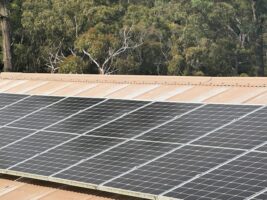The Federal Government has been urged to sideline the nation’s peak medical research body and set up a stand-alone scientific committee to investigate the health effects of wind farm noise.
The Senate Select Committee on Wind Turbines, chaired by Democratic Labor Party Senator John Madigan, has recommended the establishment of an Independent Expert Scientific Committee (IESC) on Industrial Sound to research the health effects of wind turbines “and any other industrial projects which emit sound and vibration energy” and develop a national noise standard for wind farms.
The IESC, which along with a National Wind Farm Ombudsman, would be paid for through a levy on wind farm operators, would provide advice to State governments on the health effects of any proposed or existing wind farm, and the Senate committee called for states that did not accept expert advice or adopt the national noise standard to be overruled by the Commonwealth.
The recommendations are in keeping with Government hostility to the wind power industry.
Senior Government leaders including Prime Minister Tony Abbott and Treasurer Joe Hockey have made no secret of their distaste for wind farms, and the Government recently insisted on a major cut in the national Renewable Energy Target, as well as directing the Clean Energy Finance Corporation to stop investing in wind energy projects.
The Senate Committee report will add to political tensions around renewable energy policy, which is shaping as a key battleground for the next Federal election after Labor declared it should provide 50 per cent of electricity by 2030.
Across the world countries are ramping up their investment in wind power. China has trebled its capacity since 2010 and wind now supplies enough energy to power 100 million homes. In the United States, more than 100 projects are underway and the US Department of Energy estimates it will provide 20 per cent of electricity by 2030.
The importance of renewable energy technologies was underlined by President Barack Obama who, in a speech overnight, declared power plant operators must cut slash carbon dioxide emissions by 32 per cent from 2005 levels by 2030.
“No challenge poses a greater threat to our future and future generations than a change in climate,” President Obama said.
“This is one of those rare issues, because of its magnitude, because of its scope, that if we don’t get it right, we may not be able to reverse. There is such a thing as being too late.”
The Senate Select Committee, which included cross bench senators David Lleyonhjelm and Bob Day, expressed disappointment at the AMA’s stance on the health effects of wind power. In its Postion Statement on the issue, the AMA has said there is a lack of evidence to back claims that the sound generated by wind farms affects human health.
“This is regrettable given the influence that the Association’s views have on the Australian medical community,” the Committee said. “It is hardly surprising if general practitioners turn a blind eye to, or downplay, the complaints of those who claim to be suffering the effects of wind turbines when the peak body’s assessment of the authenticity of these impacts is so dismissive.”
The Committee also cast doubt on the reliability of National Health and Medical Research Council investigations of the issue, after the nation’s peak research body reported a lack of evidence to support claims of the harmful effects of wind turbines.
It proposed the IESC take the lead on conducting research on the issue, dismissing the NHMRC’s efforts in the area as “manifestly inadequate”.
But in a dissenting report, Labor Senator Anne Urquhart shredded the credibility of Sarah Laurie, who the majority senators relied heavily upon for evidence of the adverse health effects of wind farms, as an authority on the issue.
Senator Urquhart pointed out that Ms Laurie had voluntarily given up using the title Doctor following a complaint to the Australian Health Practitioner Regulation Agency in 2013, and that numerous judges and tribunals before which she had appeared had rejected her capacity to provide expert or authoritative evidence.
In a hearing on the Stony Gap Wind Farm last year, Ms Laurie called for investigation of the theory that some people were so exquisitely sensitive to certain frequencies that from Australia they could detect an earthquake in Chile.
The judge hearing the case found that Ms Laurie’s testimony did not “contain evidence of a causal link between contemporary operating wind turbines and the kind of health problems reported by deponents”.
The judge said that Ms Laurie “rejects all studies…which are not consistent with her theories”.
A Canadian Environmental Review Tribunal hearing a case regarding the Dufferin Wind Power Project considered that the evidence presented to it by Ms Laurie “does not indicate that she has conducted a comprehensive review of all literature, nor that she has the expertise to assess the sufficiency of the research methodology in individual research studies”.
Senator Urquhart said that, in contrast to the lack of scientific evidence linking wind farms to adverse health effects, the evidence on the health effects of other forms of power generation were well-established.
While not dismissing the concerns of those who believed their health had been harmed by wind farms, the Labor Senator said many of the symptoms complained about were very common in the general population.
Adrian Rollins is the editor of Australian Medicine.










